Guitarfishes: Family Rhinobatidae
Species: Rhinobatos productus (Ayres, 1854); from the Latin word rhin (shark with a rough skin) and the Greek word batis (a ray or skate), and the Latin word product (a lengthened form, in reference to its long shape and form).
Alternate Names: Shovelnose shark, sand shark or guitarfish. Called guitarra viola in Mexico.
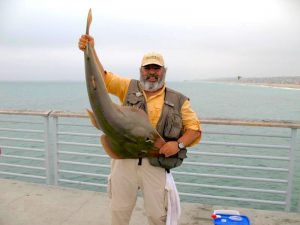
Shovelnose taken at the Hermosa Beach Pier in 2009 by my friend Mahigeer (Hashem Nahid)
Identification: They have a rather spade-shaped head with a long and pointed nose; the disk is longer than it is wide. Their body is flattened but the tail is well developed with two dorsal fins on the top. Their coloring is sandy brown above, white below. (They also have the “most soulful, woebegone eyes you have ever seen.” This last reference is from the book Certainly More Than You Want To Know About The Fishes Of The Pacific Coast by the eminent marine biologist Dr. Robin Milton Love, a book that every angler who fishes California’s coast should read.)
Size: Recorded to 61.5 inches, reported to 5 1/2 feet in length and over 40 pounds. Typical size at piers is from two to four feet. The IGFA World Record fish is listed at 28 Lbs 12 oz at Estero Bay, Ensenada, Mexico in 2021. (That record fish may be smaller than the one my friend Boyd Grant once caught at the Ventura Pier. We had no idea nor was there any interest in submitting paperwork for a possible record fish. See second picture below).
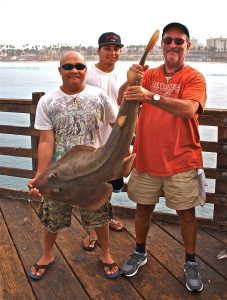
Shovelnose taken at the Oceanside Pier by “Bernie” in in 2015
Range: Southern Mexico and the Gulf of California to Tiburon, California (San Francisco Bay). Though once considered rare north of Monterey Bay, quite a few have been reported from San Francisco Bay piers since 2007.
Habitat: Generally found on sandy beaches in coastal waters as well as bays (on both muddy and sandy bottoms) to a depth of about 50 feet although recorded to a depth of 298 feet. Sometimes appears in very large aggregations (apparently when they’re in “the mood”). Typically feeds on worms, crabs, and clams.
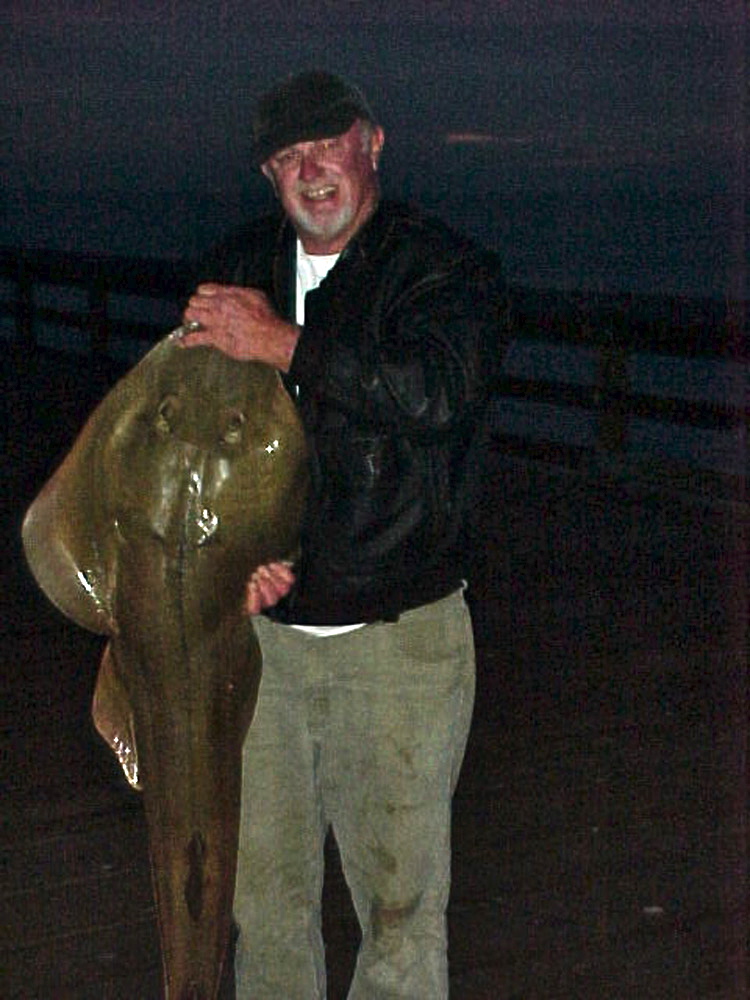
A 56 7/8-inch, 29.5-pound shovelnose that I helped net for my friend Boyd Grant back in 2002 at the Ventura Pier. It may have been a record-size fish.
Piers: One of the most common rays at all piers south of Pismo Beach and one of the favorites due to their size and the delicious meat which can be cut from the tail. Best bets: Imperial Beach Pier, Ocean Beach Pier, Crystal Pier, Oceanside Pier, San Clemente Pier, Newport Pier, Huntington Beach Pier, Seal Beach Pier, Hermosa Beach Pier, Santa Monica Pier, Ventura Pier and Goleta Pier.
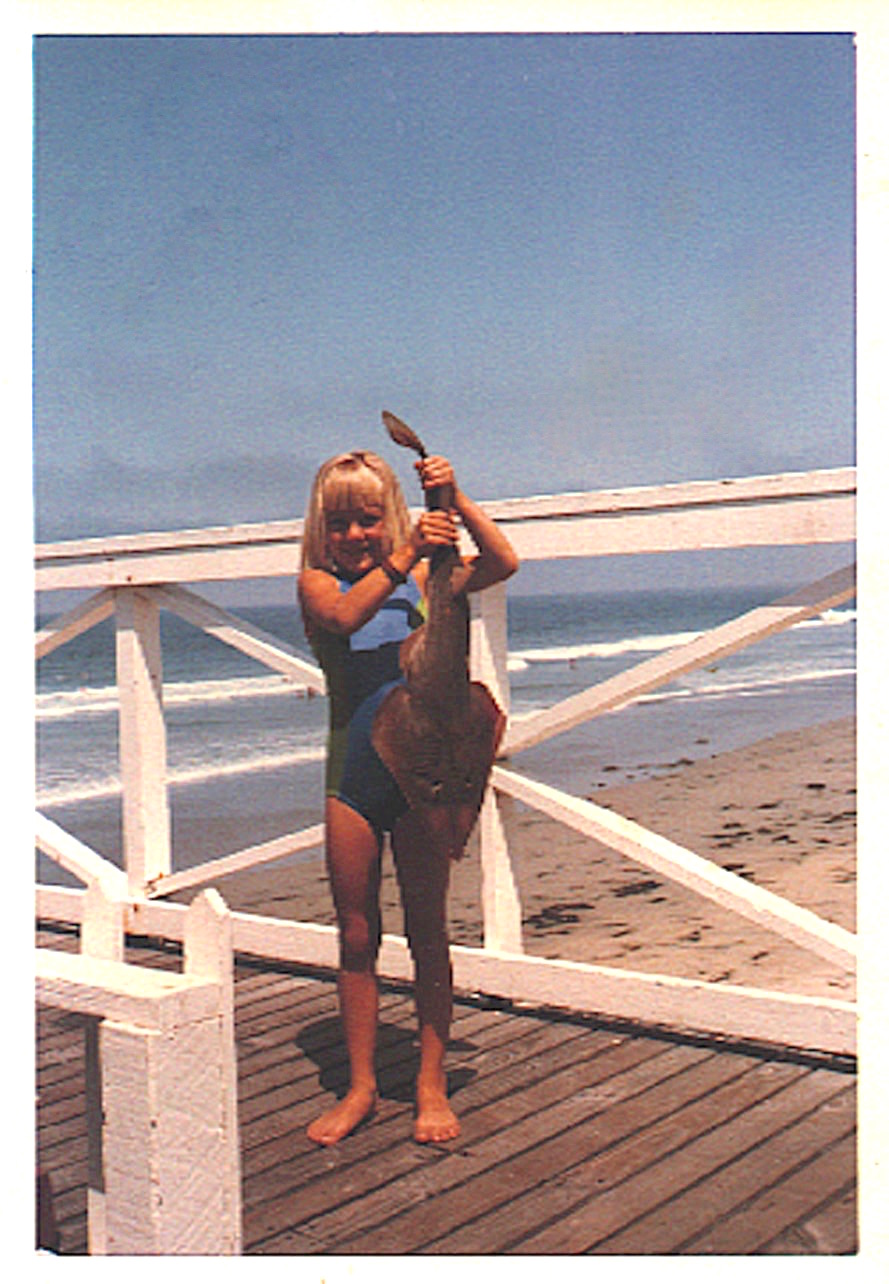
My daughter Kim’s first shovelnose taken at the Crystal Pier (San Diego) during our stay in 1977.
Shoreline: A favorite catch of southern California shore fishermen, especially in bays.
Boats: A few are caught by boaters and kayakers in San Diego Bay, Mission Bay, and San Pedro Bay.
Bait and Tackle: Since this is one of the larger fish most pier anglers will encounter, you should use at least medium saltwater tackle—twenty pound test line and size 2 to 4/0 hooks. Guitarfish will hit almost any bait but live anchovies, smelt, shinerperch and brown bait—small queenfish or white croaker—seem to work best. Other baits considered to be good include ghost shrimp, squid, clams, innkeeper worms and cut mackerel or anchovies. Bait should be fished as close to the bottom as possible and in shallow water, just past the breakers. Most commonly seen in summer and fall.
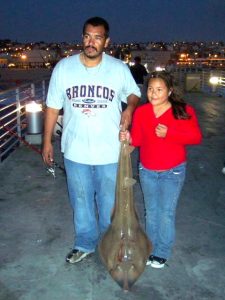
Shovelnose taken at the Hermosa Beach Pier
Food Value: A very good, mild-flavored fish. Unfortunately most anglers simply discard these fish even though, in taste and texture, the meat (found in two long, narrow fillets in the tail) is somewhat like that of expensive scallops. Suitable for several methods of cooking. Snookie, one of the seior members of the PFIC board, likes them best simply boiled and the meat used much like the shrimp in a shrimp cocktail.
My dad used to head down to Mission Bay each day, pump up some ghost shrimp, cast out two rods, sit back in his chair with his dog Mitzi, and wait for a spotfin croaker or big old shovelnose to grab his bait. He was the one who taught me that guitarfish are good eating. In fact, one day he was talking to some visitors from Seattle who had been in San Diego on a fishing trip. They had fished on boats and shore and were ready to head home. He gave them some shovelnose fillets to take with them. They called a few days later stating that they liked the meat from the shovelnose better than the other fish. In fact, they said their daughter wanted them to return, fish exclusively for shovelnose, and bring some more of the meat back home. Who would have known?
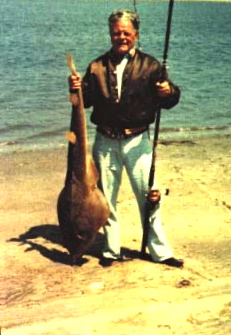
Dad and one of his shovelnose guitarfish
Comments: Remember to bring a net or pier gaff in case you hook a big fish (but only gaff fish if you intend to keep it)! And, I should add, keep the net or gaff handy. One night, during a stay at a Crystal Pier cottage back in 1977, I decided to go shark fishing. Since the pier isn’t open to the public at night, I was the only angler fishing when, at 4 A.M., a huge guitarfish decided to swallow the squid I was using for bait. It was a great fight but unfortunately the fish, which I had hooked on the north side of the pier, had circled around the end of the pier and now it was on the south side when I finally got it to the surface. I too was now on the south side. I could see a a big five-foot-long guitarfish in the light from my flashlight but I had a problem since I was alone and my treble hook gaff was sitting next to the bench on the north side of the pier. Because of the wave action I didn’t want to risk trying to maneuver the fish back around the end pilings back to the other side. I finally decided to back up and try to reach my gaff while keeping the line tight, hoping the fish wouldn’t make a new run. It almost worked except that just about the time I reached my gaff a large wave surged against the pier, the line stretched a little too tight, there was an abrupt and resounding snap in the monofilament line, and the fish was free. I was sick (to the bone) but soon adopted a Taoist-like attitude: (to quote Dylan) perhaps it was a simple twist of fate. It was the proverbial “one that got away,” and it still brings back exciting memories after all these years.
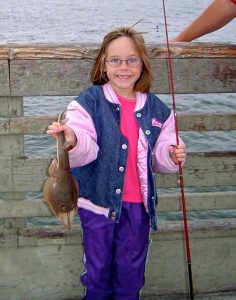
Sometimes you catch the big ‘uns sometimes the small ones. A shovelnose caught by Haley at the Ocean Beach Pie in 2004.
A related, though smaller relative, the banded guitarfish, is occasionally seen at piers in the San Diego area; most are caught from piers in San Diego Bay. (Although I have a picture of one taken at the Goleta Pier north of Santa Barbara).
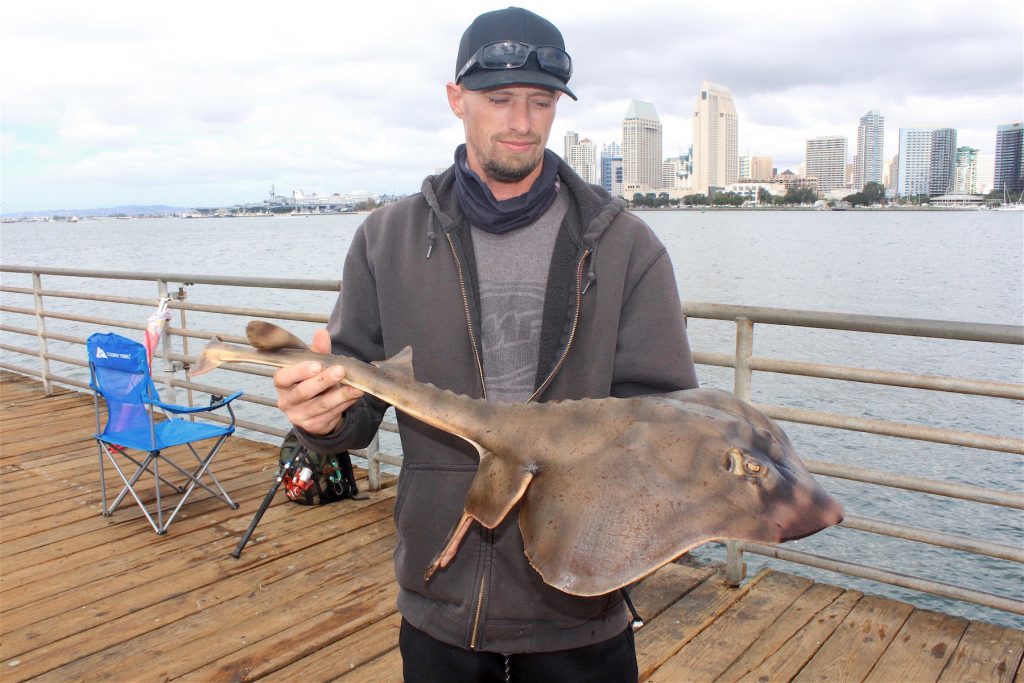
A barred guitarfish caught at the Ferry Landing Pier at Coronado in October 2021.
In Mexico, dead guitarfish are mutilated, shaped, dried, and turned into basilisks or diablos/devils and sold to naive tourists as curios.
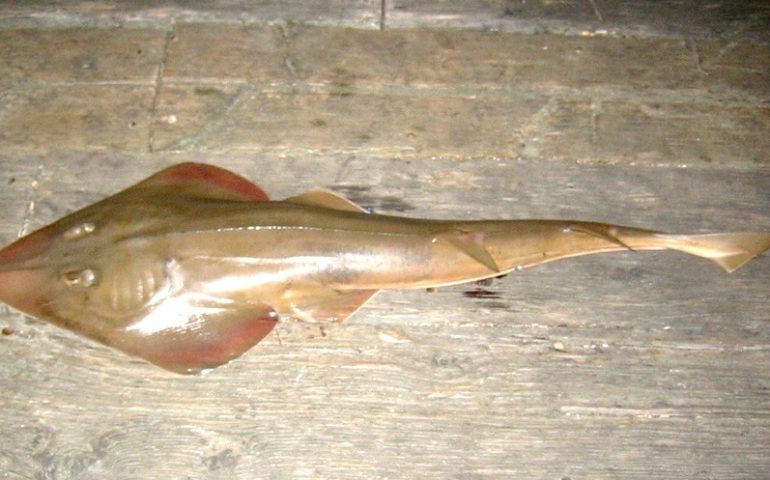
I just caught a 42” one of these on the Marin Rod &Gun Club pier beautiful fish. Released. .
When deciding how to grab your reader’s attention, consider the audience and purpose of your paper. Your hook should be relevant to the topic and flow naturally into your thesis statement and main arguments
.How to Write a Hook for a Research Paper: How to Grab Your Reader’s Attention
Make your birthday special at McDo Philippines with its fun, delicious, and budget-friendly packages. They offer various party themes and mouthwatering food deals per head. Follow 3 easy steps to party at McDonald’s and create unforgettable memories with your loved ones.